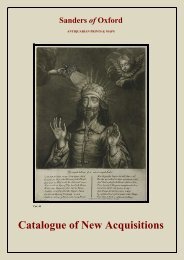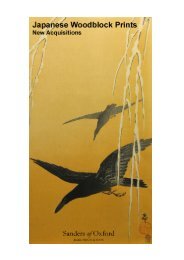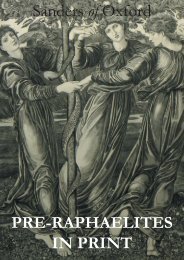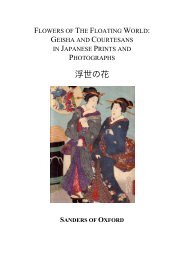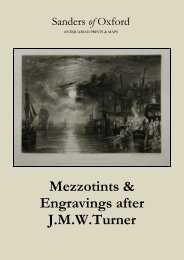catalogue text.indd - Sanders of Oxford
catalogue text.indd - Sanders of Oxford
catalogue text.indd - Sanders of Oxford
Create successful ePaper yourself
Turn your PDF publications into a flip-book with our unique Google optimized e-Paper software.
tal, Fittler became a student at the Royal Academy in 1778, and exhibited there until approximately 1824. He initially<br />
distinguished himself in the field <strong>of</strong> book illustration thanks to his engraving <strong>of</strong> works such as Thomas Dibdin’s ‘Ædes<br />
Althorpianæ’. He later turned to marine subjects, and topographical views, and was appointed marine engraver to<br />
George III.<br />
Peter Fourdrinier (d.1750) was an eighteenth-century French engraver. Part <strong>of</strong> a refugee family who fled from Caen to<br />
Holland, Fourdrinier was a pupil <strong>of</strong> Bernard Picart in Amsterdam for six years. He moved to England in 1720 where<br />
he was employed to engrave portraits and book illustrations. He is best known for his architectural engravings, to<br />
which his mechanical style was well suited. He engraved plates for Cashel’s ‘Villas <strong>of</strong> the Ancients’, Ware’s ‘Views<br />
and Elevations <strong>of</strong> Houghton House, Norfolk’ (1735), Sir W. Chambers’s ‘Civil Architecture’ (1759), Wood’s ‘Ruins<br />
<strong>of</strong> Palmyra’ (1753) and others from the designs <strong>of</strong> Inigo Jones, W. Kent, and other architects. He also engraved the<br />
illustrations to Spenser’s ‘Calendarium Pastorale’ (London, 1732, 8vo).<br />
C. A. Fesch was an artist and lithographer active in the late nineteenth and early twentieth-century. Fesch is best<br />
known for sporting and equestrian scenes including ‘Going to the Meet, Present Day’, c.1900, ‘Cycling at Alexandra<br />
Palace’,1886, and ‘Stagecoach to St. Albans’ c.1880.<br />
Thomas Gaugain (1756 - c.1810) was a copyist and engraver. Born in Abbeville, France, he came to London at a<br />
young age and spent his entire career in England. He entered the Royal Academy Schools in 1771 and exhibited there<br />
from 1778-82. Not only was Gaugain a prolific worker, but he ranks amongst the most talented stipple-engravers <strong>of</strong><br />
the late eighteenth-century.<br />
John Alexander Gresse (1741 - 1794) was an English draughstman, painter and engraver. Born in London, Gresse<br />
studied drawing under Gerard Scotin, and and was one <strong>of</strong> the first students to work in the gallery <strong>of</strong> casts founded by<br />
the Duke <strong>of</strong> Richmond. In 1777, he was appointed drawing-master to the Royal Princesses. He occasionally practised<br />
etching; publishing ‘St. Jerome’ after Guido, and ‘A Satyr Sleeping’ after Poussin. Gresse was also a great collector <strong>of</strong><br />
works <strong>of</strong> art and an auction <strong>of</strong> his collection shortly after his death lasted for six days.<br />
Charles Grignion the Elder (1721 - 1810) was a British engraver and draughtsman. He trained under Hubert Francois<br />
Gravelot, before working in Paris for J. P. Le Bas. Upon his return to London, Grignion received further education<br />
from Gravelot and G. Scotin, before commencing work <strong>of</strong> his own accord from approximately 1738 onwards. His<br />
skills in draughtmanship and purity <strong>of</strong> line meant that Grignion was a popular book illustrator. He produced engravings<br />
for Walpole’s ‘Anecdotes <strong>of</strong> Painting,’ Smolett’s ‘History <strong>of</strong> England,’ as well as Dalton’s ‘Antique Statues.’<br />
Hogarth thought very highly <strong>of</strong> Grignion, and commissioned him on several occassions, as did Stubbs, who is thought<br />
to have initially wanted Grignion to engrave the plates for ‘The Anatomy <strong>of</strong> a Horse.’<br />
John Callcott Horsley (1817 - 1903) was a painter, etcher and draughtsman on wood. He was elected to the Royal<br />
Academy in 1864, and also served at the institution as the pr<strong>of</strong>essor <strong>of</strong> drawing. Horsley was a member <strong>of</strong> The Etching<br />
Club; an artists’ society founded in London in 1838 by Charles West Cope. In addition to regular folios such as<br />
‘Etched Thoughts’, the club published illustrated editions <strong>of</strong> works by authors such as Oliver Goldsmith, Shakespeare,<br />
John Milton and Thomas Gray. The plates were made at meetings, later revised, and then commercially sold.<br />
Henry Howard (1769 - 1847) was an English portrait and history painter. He was born in London, and from 1786-1793<br />
was a pupil <strong>of</strong> Philip Reinagle; whose daughter he later married. He entered the Royal Academy schools in 1788, and<br />
exhibited their from 1794 until his death in 1847. He became secretary to the institution in 1811, and was made the<br />
Pr<strong>of</strong>essor <strong>of</strong> Painting in 1833. Howard met John Flaxman in Rome in 1791, and the Neo-classical propensity <strong>of</strong> his<br />
works pays tribute to this encounter.<br />
Louis Icart (1880 - 1950) was a famed French artist who worked in the Art Deco manner. Born in Toulouse, Icart<br />
intially pursued a career in fashion, and was employed in major design studios at a time when fashion was radically<br />
contorting. It was not until his move to Paris in 1907, and his subsequent concentration on painting, drawing and the<br />
production <strong>of</strong> countless etchings, that Icart’s name was indelibly preserved in twentieth-century art history. His sensuous<br />
and erotic depiction <strong>of</strong> women, <strong>of</strong>ten imbued with comedic undertones, struck a chord with Parisians at the height<br />
<strong>of</strong> the Art Deco epoch in the 1820’s. There is certainly something both sensuous and comedic in Icart’s depiction <strong>of</strong><br />
Goethe’s Faust as Mephistopheles and Gretchen mirror each other. The features <strong>of</strong> the former are comedically pointy,<br />
whereas Gretchen is shown as both pious and lascivious.<br />
James Kirkwood & Son were a prolific firm <strong>of</strong> engravers towards the end <strong>of</strong> the eighteenth and the early nineteenth-




